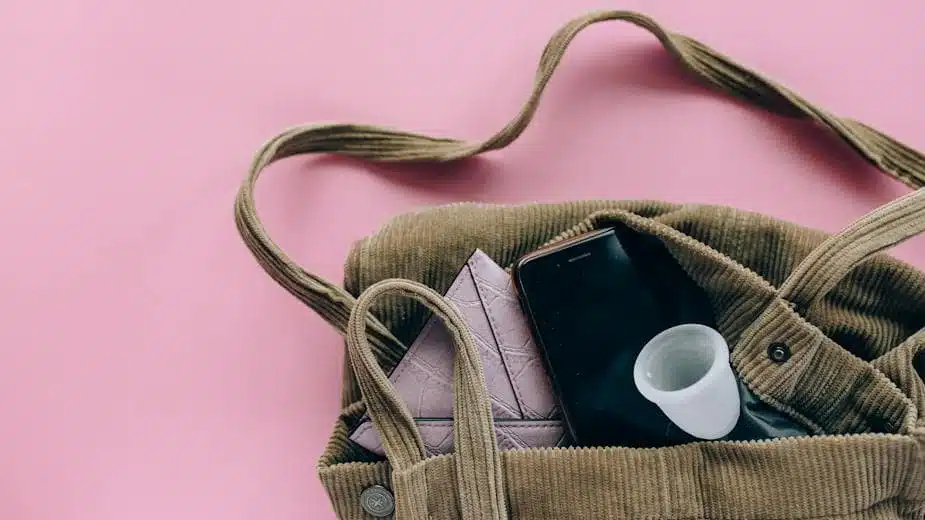Welcome to the complete guide on mastering use of the menstrual cup to enhance your monthly cycle. If you’re tired of the waste, cost, changing hassles, and discomfort that come with old school period products like pads and tampons, I have good news. The top eco-friendly alternative that saves money, is healthy for your body, has many advantages, and can transform your cycle experience is adopting the menstrual cup.
What is a Menstrual Cup?
A menstrual cup is a small, flexible cup made of medical-grade silicone that is worn internally during your period to catch the blood flow. Rather than absorbing the blood like pads and tampons, the cup collects it, allowing you to go up to 12 hours leak-free, even on heavy days. When ready to empty, simply remove the cup, pour out the contents, wash, and reinsert for many years of use. Menstrual cups are revolutionizing cycle care with a wallet and environmentally-friendly method.
How Do Menstrual Cups Work?
Menstrual cups have a shape similar to a lightbulb, funnel, or chalice. The rim creates a seal against your vaginal walls via suction to prevent leaks or spills. Most feature a slender stem on the base to make removal easy by grasping it with your fingers to slide the cup out. The blood and uterine lining collect in the hollow cup, rather than on pads or tampons. When full after up to 12 hours, take it out, empty in the toilet, wash clean, and slide back in. At the end of your cycle, sterilize it by boiling for 10 minutes and it’s ready for next month with proper care lasting approximately 10 years.
Menstrual Cup Sizes: Which is Right for Me?
Menstrual cups now come in a range of sizes to match your body, age, whether you’ve given birth, and flow level. The 4 main sizes are:
- Teen/Youth: Designed for young girls just starting their period who haven’t given birth. Extra small size and firmness.
- Small Size: Best for light to moderate flow, petite anatomy, under 30 years old.
- Large Size: Ideal for women with heavy periods, over 30, or who’ve had a vaginal birth. Higher capacity.
- Extra-Large Size: For heaviest flows like postpartum.
If unsure, try a smaller cup first for comfort and work up a size as needed. Most companies sell a twin pack with both sizes to experiment. To determine sizing, consider flow heaviness, height of cervix, pelvic floor muscles tone, and if you’ve had a vaginal delivery. Low cervixes often do better with a shorter cup. Measure yours by inserting a clean finger and noting where your cervix sits. Those with strong Kegel muscles can use firmer cups that pop open easily. Moms benefit from softer cups that conform.
Menstrual Cup Materials:
Medical Grade Silicone vs. Latex Rubber vs. Thermoplastic Elastomer (TPE)
Today, most quality menstrual cups are medical grade silicone which is pliable, durable, hypoallergenic, and healthier for sensitive vaginas. Avoid latex rubber cups if you have a latex allergy. Cheaper cups may be Thermoplastic Elastomer (TPE) which can absorb stains and odors. Know the cup material before buying for factors like safety, eco-friendly manufacturing, ethics, care recommendations and more. Reusable cups should display an ISO 10993-1 safety certification mark.
Menstrual Cup Shapes Matter
- Bell Shape The classic shape works well for many. A nice starter cup. Gets wider near the base.
- V Shape Taller and more slender. Can fit better for active lifestyles. The gradual taper aids insertion.
- Round/Tulip Shape Unique tulip silhouette fits many vaginas flawlessly. Rounded design is user friendly.
- Asymmetrical/Funnel Shaped Angled higher on 1 side to sit not quite perpendicular to your cervix. Game changer for wonky anatomy!
How to Insert a Menstrual Cup Properly
Choose your cup size, grab lube if desired, and have handy disposable wipes or wet washcloth if preferred to toilet paper for practicing at home until you get the hang of it. Then follow these simple steps:
- Wash hands thoroughly with soap, wear gloves optionally
- Apply water-based lubricant to rim if wanted or wet cup
- Fold cup into a U, 7, punch-down, origami, diamond etc. shape
- Carefully insert into vagina at 45 degree angle towards tailbone
- Make sure cup pops open, creates suction seal on walls
- Give a gentle rotational tug to check if properly placed
- Can trim stem partially if irritating or rubbing outside
Inserting a menstrual cup takes some technique, but gets way easier fast once you figure out what fold style works best for your anatomy. Don’t get discouraged! Inserting while squatting in a hot shower helps many first timers until they get confident.
How to Remove a Menstrual Cup
Removing properly prevents messes as the cup will be full of blood and uterine lining when you take it out. Follow these instructions:
- Always wash hands thoroughly first
- Relax muscles by deep breathing
- Gently pull stem or reach up to base to pinch and break seal
- Tip cup horizontal as you slide out gently
- Pour contents into toilet before washing
Removing is simplest if you remember to stay relaxed rather than tense up. Push down like going to the bathroom to lower the cup in reach. Practice makes perfect! Empty contents, wash cup in sink with menstrual cup soap, reinsert and go!
Top 10 Benefits of Switching to a Menstrual Cup
- Save tons of money. 1 cup lasts approx 10 years with proper care and sanitizing.
- Eco-friendly reusable cup keeps 100’s of pads/tampons from landfills. Low waste!
- Comfortable, leak-proof for up to 12 hours, even heavy flows, swimming etc. Freeman feeling!
- No exposure to irritating bleaches, chemicals, or synthetic fibers in conventional period products.
- Lower risk of infections like TSS with sterilized medical grade silicone.
- Can be safely worn overnight for uninterrupted sleep. No worrying about accidental leakage on sheets!
- Odor reducing design contains rather than exposes blood to air. Discreet period care.
- No dryness issues like with cotton tampons. Healthier for sensitive vaginal tissue.
- Intercourse friendly designs available. Mess free sex on your period is possible!
- Perfect for activities like travel, camping, festivals, beach days, long shifts and more thanks to the durable, versatile design that keeps up with your lifestyle.
Menstrual Cup FAQs: Common Concerns Answered
How do I know which size to buy?
Follow sizing guidelines and consider factors like age, babies birthed, cervix height, and flow. Buying twin packs with both sizes can allow experimenting before deciding if unsure.
Can I wear a cup with an IUD?
Most brands now state it is safe to use a cup with IUD’s like Mirena after checking with your OB-GYN. Proper placement prevents traction on strings. New studies eased prior worries on dislodging risks.
Do menstrual cups cause TSS like tampons?
Toxic Shock Syndrome is very rare among cup users given the medical grade materials versus fibers of tampons. Maintain hygiene by cleaning properly and no significant TSS worries exist.
Can I have sex with the cup inserted?
Some menstrual cup brands now offer “intimina” designs specifically for mess free intercourse on your period. Softer rims stay tucked out of the way. Check for sex safe cups if this is important to you.
Do I need to trim the stem?
The slim stem aids removal but can uncomfortably poke outside if too long for your anatomy. Test by wearing on lightest day and trim incrementally if rubbing happens.
Troubleshooting Menstrual Cup Problems & Solutions
- Leaking – Didn’t fully pop open so reinsert and give a gentle tug to seal suction. Choose larger capacity for very heavy flow.
- Difficult to remove – Stay relaxed during extraction, bear down, remove at 45 degree angle. Try different folds that work better with your muscles and anatomy. Consider a longer stem or ring pull design if struggling to grasp base.
- Uncomfortable – Assess sizing. A too firm or inflexible cup can cause bladder pressure. Opt for a softer style if experiencing cramps or sensitivity issues. Make sure it’s fully opened.
- Messy to empty – Pour slowly over toilet to catch drips, wipe cup rim carefully before reinserting to prevent staining clothes or leaking from tiny holes that comprise the suction seal.
Menstrual Cup Care & Longevity Recommendations
Between cycles: Wash cup in mild, scent-free soap. Store open air in included pouch/bag.
Sanitizing: Sterilize cup by boiling 5-10 minutes at end of each cycle. Harsh bleach or chemicals can degrade the medical grade silicone, shortening longevity and harboring bacteria over time in tiny pores. Some alternative sanitizing options between boiling sessions that are gentler on cups include:
- Hydrogen Peroxide Soaks – Mix a solution of 1 part 3% hydrogen peroxide to 4 parts water in a clean container or cup. Submerge your sterilized menstrual cup completely in the hydrogen peroxide bath and let soak 5 minutes. This kills germs and lightens stains without bleach use. Rinse well before reinserting next cycle.
- UV Menstrual Cup Sanitizing Devices: Convenient wands with UV-C light technology exist that zap 99.9% of germs in under 5 minutes for easy cleaning between uses if boiling seems cumbersome when out and about.
Menstrual Cup Washing Tips: Avoid harsh soaps. Stick to gentle, fragrance free cleansers designed for period care accessories to prevent irritation or imbalance. Make sure tiny suction release holes around cup rim are clear of debris each wash.
Signs A Replacement Cup Is Needed:
- Odor that won’t come clean
- Punctures, holes, or tears
- Warping or deforming from heat/pressure
- Gaps in the silicone material
- Severe staining or clouding
- Suction decrease over time
- Product expiration date surpassed
- Sensitivity develops suddenly
Compare Menstrual Cups to Discs
Menstrual discs provide another reusable, eco-friendly period management option that collects flow rather than absorbing. Key contrasts between cups and discs:
- Shape/Design Differences:
- Cups = Bell shaped basin that conforms via suction
- Discs = Shallow plastic oval dome that sits in place under pubic bone
- Capacity Variances:
- Cups hold more overall fluid volume for very heavy days. up to 3 times that of a disc.
- Intercourse Considerations:
- Discs stay tucked out of the way for mess-free period sex but must be careful not to displace. Cups should be removed beforehand.
- Learning Curve Comparison:
- Inserting discs viewed as moderately easier by some cup converts but removing discs often ranked harder and messier by reviewers.
Which is ultimately best comes down to unique factors like flow level, anatomy, activity lifestyle, and personal preference. Both reusable options beat disposables for health, environmental, and affordability gains!
Embrace The Menstrual Cup Upgrade!
Hopefully, this guide has eased all concerns about making the menstrual cup switch. Their huge upsides vastly outweigh small transition adjustments. Don’t be afraid to experiment with brands, sizes, folding techniques until discovering your custom fit for cycle comfort and freedom!
Join millions of women worldwide leveraging cups to cut costs, restore body harmony through safer materials against delicate tissue, reduce period waste radically, and reclaim total flexibility while menstruating. The future of period care has arrived full circle back to simple, sustainable solutions in the menstrual cup. Your body and wallet will thank you!



